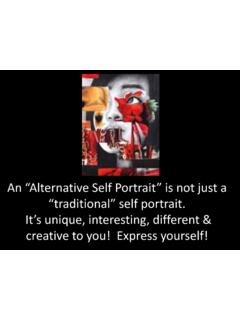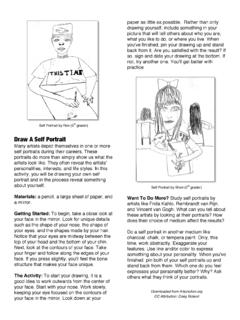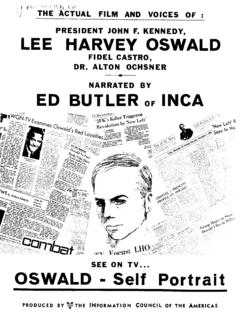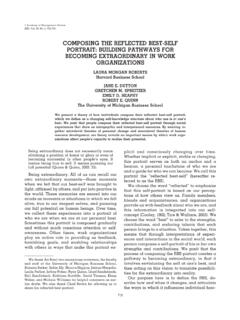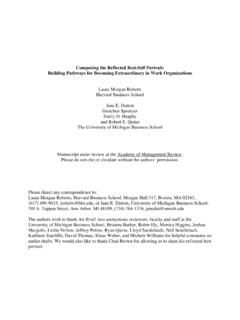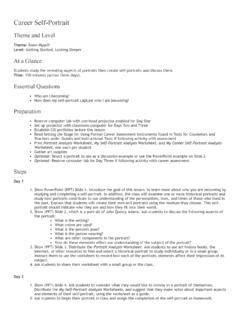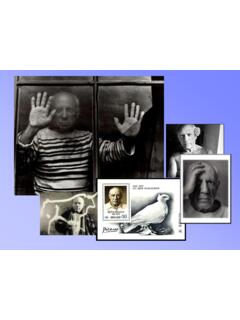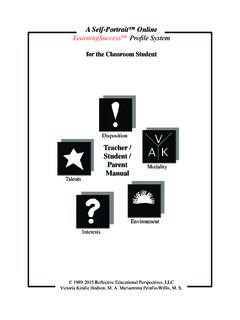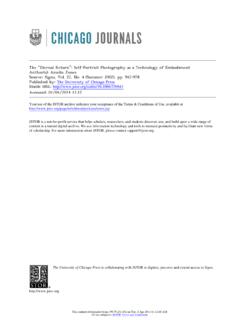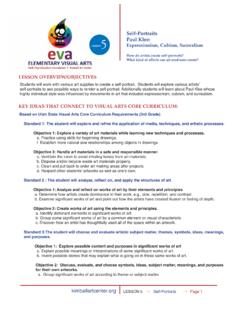Transcription of COMPREHENSION QUIZ: The Art of Drawing
1 SEPTEMBER 2015/SKILLS SHEETName _____Class _____Uses: copying machine, opaque projector, or transparency master for overhead projector. Scholastic Inc. grants teacher-subscribers of Scholastic Art permission to reproduce this page for use in their classrooms. 2015 by Scholastic Inc. All rights QUIZ: The Art of DrawingUse the September 2015 issue of Scholastic Art to answer the questions. Fill in the circle next to the correct answer. 1. Although lines can be found in art of most any medium, they are most clearly observed and analyzed in _____. (pages 4-5) A painting B sculpture C Drawing D photography 2. In portraying a bull in the Lascaux Cave, the artist uses a simple _____ to represent the animal. (pages 4-5) A diagram B outline C zigzag D shadow 3. In his work on page 5, Camille Pissarro uses a diagonal line to create the illusion of _____.
2 A depth B light C color D height 4. The Renaissance was a period in which people began to use _____ to study the world. (pages 6-7) A iPads B observation C language D computers 5. In the anatomical Drawing on page 7, Leonardo da Vinci uses varied _____ to show how the bones of the torso fit together. A colors B patterns C line weight D zigzags 6. Pablo Picasso _____ his Dove With Flowers by Drawing the bird with only a few quick lines against a white background. (pages 8-9) A simplifies B juxtaposes C contours D repeats 7. Fernand L ger uses cross-hatching to create a wide range of _____ in his ink Drawing of hands and feet. (pages 8-9) A tones B outlines C media D planes 8. To create a sense of movement, Lo s Mailou Jones utilizes thin, _____ lines. (pages 8-9) A diagonal B realistic C dynamic D contour 9.
3 In his Caf Terrace on the Place du Forum, Vincent Van Gogh develops a repeating _____ in the cobblestones to show depth in the scene. (pages 10-11) A highlight B detail C shadow D pattern 10. Van Gogh replaces the scalloped awning edge in his preparatory sketch with a clean line in his final painting, creating a strong _____ between the caf and street. (pages 10-11) A contrast B pattern C barrier D compositionDEBATE: Problem in PinkWhich side of the debate are you on? Use the boxes below to organize your thoughts about the debate in the September 2015 issue of Scholastic Art. Name _____Class _____SEPTEMBER 2015/SKILLS SHEETUses: copying machine, opaque projector, or transparency master for overhead projector. Scholastic Inc. grants teacher-subscribers of Scholastic Art permission to reproduce this page for use in their classrooms.
4 2015 by Scholastic Inc. All rights _____ _____Part I:Why does Marco Evaristti consider this project a work of art?Part II:Why are local authorities and landowners upset by Evaristti s project?Part III:Is the fine Evaristti faces justified? Why or why not? Write your answer on a separate sheet of : copying machine, opaque projector, or transparency master for overhead projector. Scholastic Inc. grants teacher-subscribers of Scholastic Art permission to reproduce this page for use in their classrooms. 2015 by Scholastic Inc. All rights REVIEW: The Art of DrawingUse the September 2015 issue of Scholastic Art to answer the questions. Write your answers in complete sentences on a separate sheet of 2015/SKILLS SHEET1. What makes line one of the key elements of art? (pages 4-5)2. How does Rembrandt van Rijn develop the shadows in his self - portrait on page 4?
5 3. How does Janet Fish use line to show shape? (pages 4-5)4. In what way does Leonardo da Vinci use line to draw machines and inventions? (pages 6-7)5. How does Leonardo show the woman s facial features in The Head of Leda? (pages 6-7)6. How do Albrecht D rer s contour lines create the illusion of three-dimensional shape? (pages 8-9)7. Why are the dark lines in Lo s Mailou Jones s work described as having a graphic power ? (pages 8-9)8. What is the purpose of a preparatory sketch? (pages 10-11) 9. What patterns does Vincent van Gogh incorporate in both his preparatory sketch and final painting of Caf Terrace on the Place du Forum? (pages 10-11)10. How does Van Gogh use line to portray the street receding into the background? (pages 10-11)Name _____Class _____SEPTEMBER 2015/SKILLS SHEETSKETCHBOOK STARTERS: The Art of DrawingChoose at least four sketchbook prompts from the list below.
6 Cut them out and glue each to the top of a separate page in your sketchbook. Then make a Drawing for each, following the instructions. Use the September 2015 issue of Scholastic Art for inspiration. Uses: copying machine, opaque projector, or transparency master for overhead projector. Scholastic Inc. grants teacher-subscribers of Scholastic Art permission to reproduce this page for use in their classrooms. 2015 by Scholastic Inc. All rights _____Class _____Cut a photograph from a magazine. Use line to draw on the image, transforming it into a mixed-media outline to draw an animal in the style of a cave your cell phone to take a selfie. Sketch a self - portrait based on the photograph. Use lines to create highlights and shadows that accentuate your your classroom. Use diagonal lines to create a sense of varied line weight to create a diagram of an imaginary flying machine that could transport you and your friends to stylized, dynamic lines to sketch your favorite animal in up with a partner.
7 Draw each other s clasped hands, using cross-hatching to define the fingers and show the direction of the light three small objects on a desk or table, in varying distances away from you. Sketch the objects using varying line weight and shading to create a sense of a black marker, draw your favorite fruit using contour lines. Add color with colored pencils or markers. Sketch a scene using thick, thin, dotted, straight, curved, diagonal, vertical, horizontal, hatched, and cross-hatched lines. Be sure to experiment with line length. TAKE NOTES: Working With LineUse the September 2015 issue of Scholastic Art to complete the chart below. Make notes about the types of lines the artists use in each of the drawings _____Class _____SEPTEMBER 2015/SKILLS SHEETUses: copying machine, opaque projector, or transparency master for overhead projector.
8 Scholastic Inc. grants teacher-subscribers of Scholastic Art permission to reproduce this page for use in their classrooms. 2015 by Scholastic Inc. All rights USAGEL ascaux Cave ArtistBull and HorseoutlineRembrandt van RijnSelf-PortraitCamille PissarroYoung Black Woman SittingJanet FishBox of PeachesLeonardo da VinciThe SkeletonLeonardo da VinciThe Head of LedaPablo PicassoDove With FlowersHenri de Toulouse-LautrecFrancois GauzyAlbrecht D rerPraying HandsFernand L gerFoot and HandsLo s Mailou JonesMen WorkingCOMPARE & CONTRAST: Preparatory Sketch and PaintingUse the September 2015 issue of Scholastic Art to complete the graphic organizer below. Make notes about the types of lines Vincent van Gogh uses in the preparatory sketch on page 10 and the painting on page 11. Name _____Class _____SEPTEMBER 2015/SKILLS SHEETUses: copying machine, opaque projector, or transparency master for overhead projector.
9 Scholastic Inc. grants teacher-subscribers of Scholastic Art permission to reproduce this page for use in their classrooms. 2015 by Scholastic Inc. All rights are they different?Preparatory SketchHow are they similar?PaintingSEPTEMBER 2015/SKILLS SHEETUses: copying machine, opaque projector, or transparency master for overhead projector. Scholastic Inc. grants teacher-subscribers of Scholastic Art permission to reproduce this page for use in their classrooms. 2015 by Scholastic Inc. All rights _____Class _____VISUAL VOCABULARY: The Art of DrawingExperiment with different types of lines to show the three-dimensional shape of an apple. Use the September 2015 issue of Scholastic Art for LINESVARIED LINE WEIGHTSEPTEMBER 2015/SKILLS SHEETUses: copying machine, opaque projector, or transparency master for overhead projector.
10 Scholastic Inc. grants teacher-subscribers of Scholastic Art permission to reproduce this page for use in their classrooms. 2015 by Scholastic Inc. All rights PUZZLE: The Art of DrawingUse the September 2015 issue of Scholastic Art to help you solve the crossword 1. _____ lines create depth and pull the viewer s eye to the background of a Drawing . 4. Artists like Vincent van Gogh often create preparatory _____ to help them compose their paintings. 8. An artist might create these drawings to illustrate the inner workings of machines. 10. Areas of parallel lines 12. Sets of repeated images 13. To reduce a form to a basic shapeDOWN 2. A line that defines the shape of an object 3. _____-hatched lines crisscross each other, adding density and value. 5. Leaving parts of an illustration white is one way to create _____.
